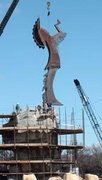It is now official. A recession began in 2007. The National Bureau of Economic Research's Dating Committee met by phone Friday and made that decision. Looking at monthly indicators and cross checking them against various ways of aggregating quarterly GDP, they judged the recession started in December of last year.
But the Dating Committee should beware. Its analysis is vulnerable to revisions. The data as currently reported shows payroll employment peaked in December, 2008. The Committee looked at various other significant indicators peaked between November, 2007 and June, 2008. Our experience from the 2001 recession was that the payroll employment data got revised down dramatically well after the fact. Since the Bureau of Labor Statistics (BLS) adjusts the data each month for firm births and deaths, it overestimates job growth during recessions. I expect the same will happen again. That would move the payroll employment peak back. A downward revision in payroll employment would also cause personal income minus transfers and GDP to be revised downward.
I agree the economy turned down in 2007. I would argue for an earlier date than December: perhaps one of the summer months. The household survey data indicate an earlier downturn. Employment divided by population peaked in December, 2006 (i.e. a year earlier) and the unemployment rate bottomed out in March, 2007 (nine months earlier.) I rely on the ratios because they avoid difficulties associated with the time series of the household employment aggregates. The household data should do a better job of picking up employment weakness tied to the sectors at the center of the drama: mortgage brokers, real estate agents, and construction workers. Housing starts peaked in January, 2006 (a month or two earlier if you look at the moving averages) and had fallen about 40 percent by summer, 2007.
Monday, December 01, 2008
Subscribe to:
Post Comments (Atom)

2 comments:
I would have to agree, I think our recession probably started a little earlier than December of last year. However, I can see why, all the leading indicators point to December 07, even though I don't think anybody last December was to worried about a looming recession. However, with gas prices on the rise early in the year and peaking this summer I an understand why we are now in a full blown recession. I think that is the time when consumption spending just went to a standstill.
I have wondered why the NBER does not set standards when defining a recession. The obscurity to which the NBER defines recessions creates confusion. However after thinking about it, maybe its not so bad that there are no definitive rules outside of the downward activity after a peak. As the article stated some substantial economic measures may remain positive but the economy is in actuality experiencing a recession. And that is why, I suppose, the firms judgement and not set standards define a recession. With the word recession being the evilist word in the economic dictionary, everyone takes great measure to prevent them. Thus with set standards certain measurments could be altered and buffered to keep recessions from occuring when the real economy is in fact experiencing downturns. That is why it is probably a good thing that the committee uses judgement to decide when peaks and troughs have occured.
Post a Comment